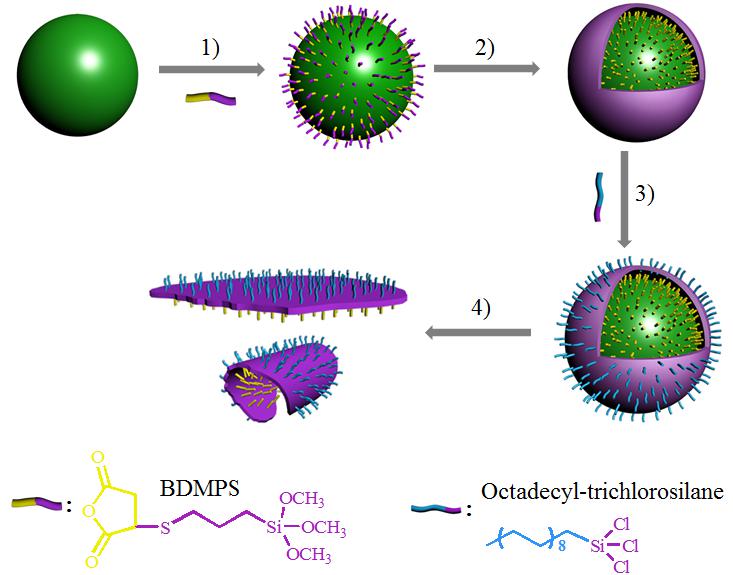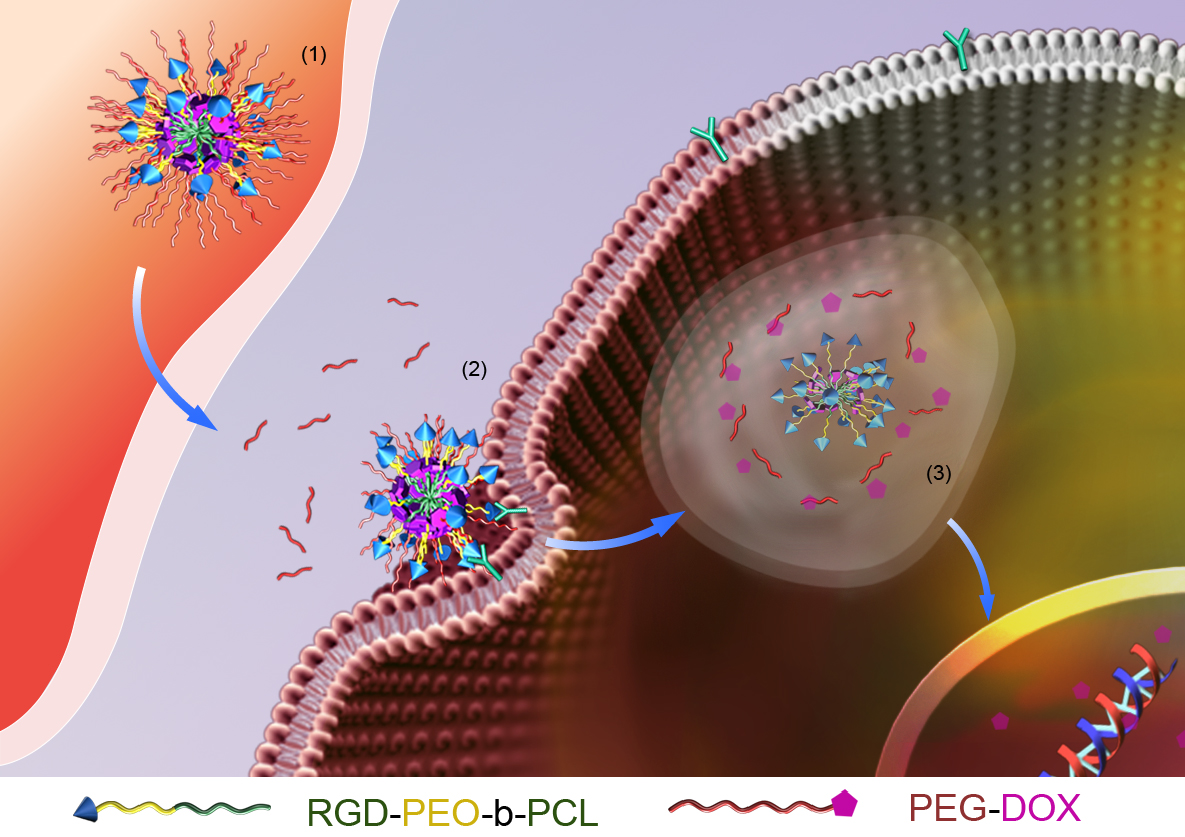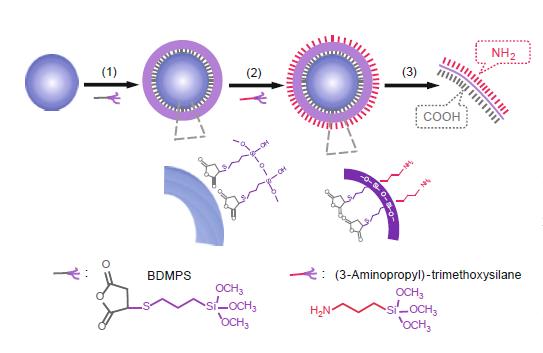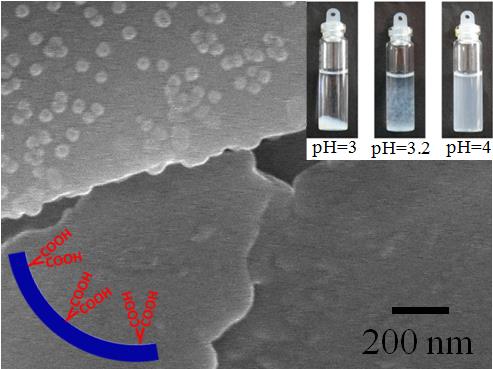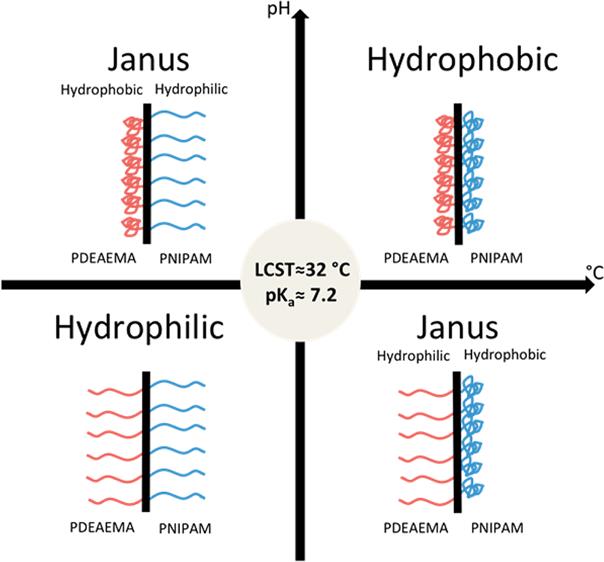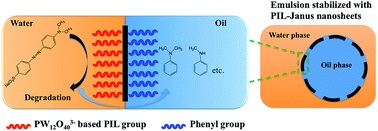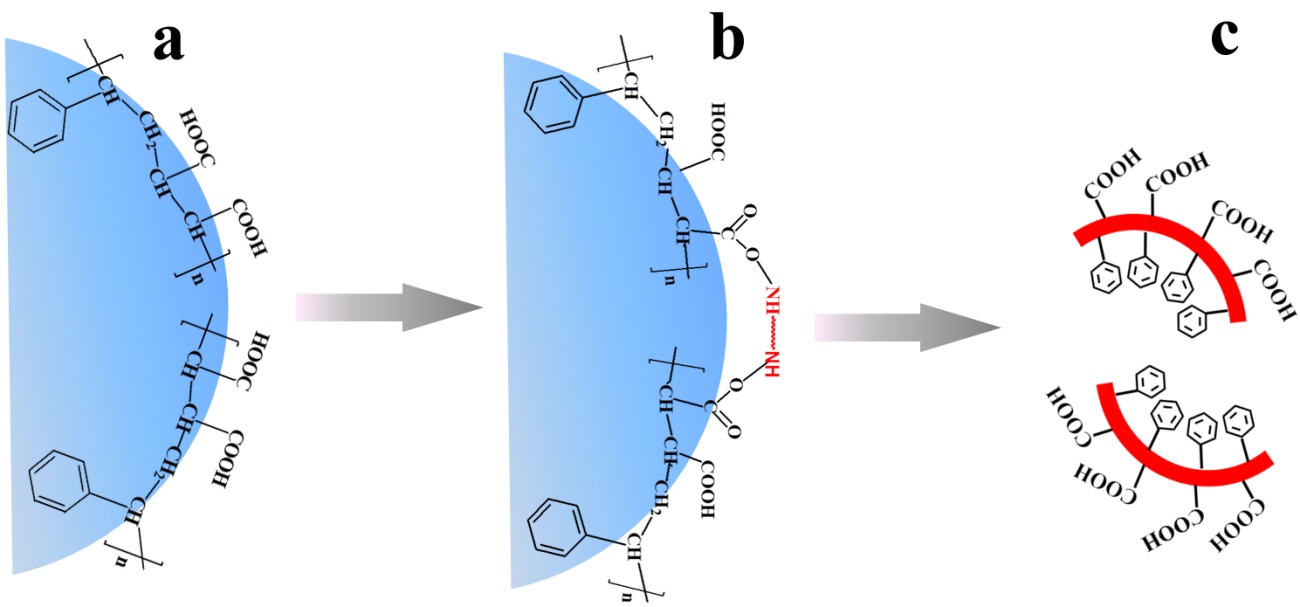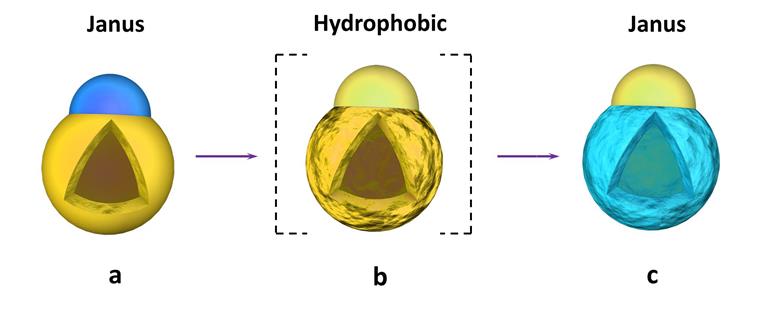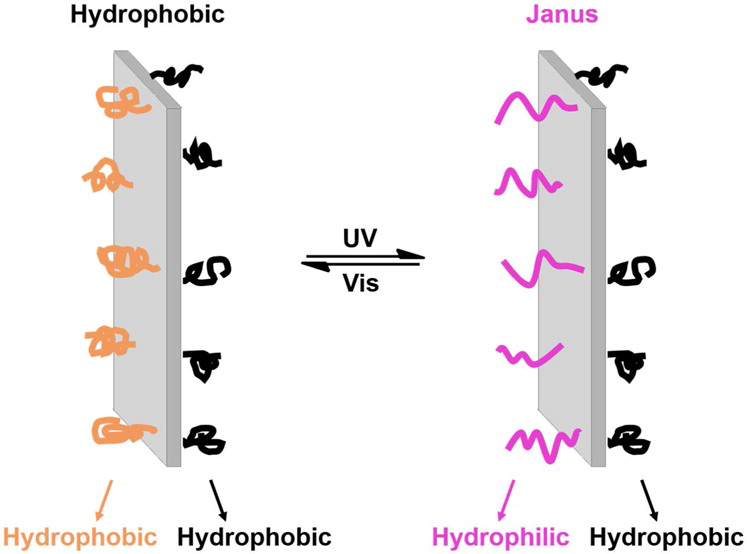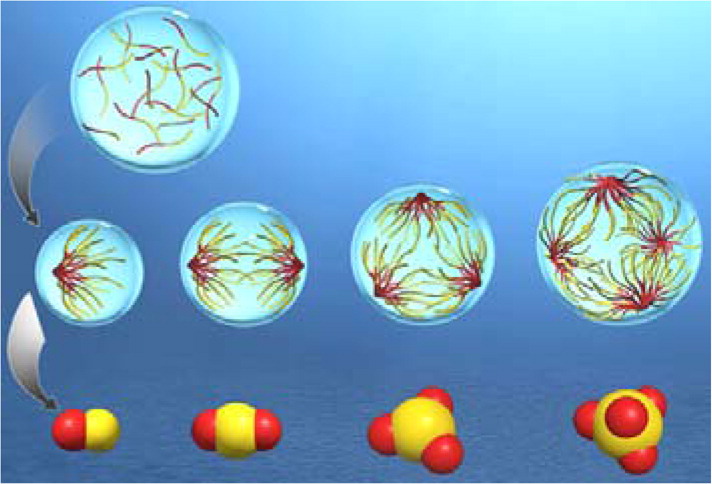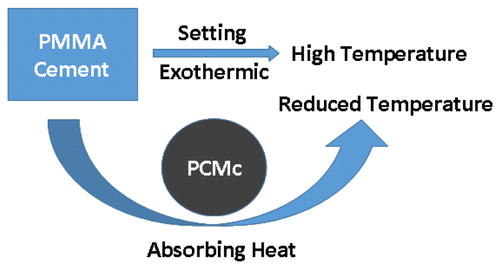 2015
2015
1. Y. J. Liu, F. X. Liang*, Q. Wang, X. Z. Qu, Z. Z. Yang*, "Flexible Responsive Janus Nanosheets" , Chem. Commun. 2015, 51, 3562-3565.
Flexible Janus nanosheets of molecular scale thickness (3.5 nm) are massively fabricated by sol-gel process of self-assembled monolayer of an amphiphilic silane onto a template. Groups of both sides are tuneable thus performance of the nanosheets for example pH responsive. As a flexible solid emulsifier, desired species can be wrapped with an individual nanosheet, which is pH triggered.
2. R. H. Deng, F. X. Liang*, X. Z. Qu, Q. Wang, J. T. Zhu*, Z. Z. Yang*, "Diblock Copolymer Based Composite Janus Nanoparticles", Macromolecules 2015, 48, 750-755.
We herein report a facile method to prepare diblock copolymer based composite Janus nanoparticles via a self-assembly/disassembly strategy. By emulsion-solvent evaporation method, diblock copolymers polystyrene-block-poly (4-vinylpyridine)(PS-b-P4VP) self-assemble into patchy particles with P4VP protuberances on their surfaces. Crosslinking these protuberances with 1, 5-diiodopentane (DIP), gold nanoparticles (Au NPs) or SiO2 and then selective disassembling continuous phase of the particles with a good solvent of PS can thus produces composite Janus nanoparticles. They are amphipathic nanoparticles, consisting of hydrophilic Au/P4VP and hydrophobic PS on two sides. We further demonstrate their self-assemble behavior in binary solvent mixtures. Super-aggregates with various structures are observed depending on the solvent property.
3. H. Zhao, F. X. Liang*, X. Z. Qu, Q. Wang, Z. Z. Yang*, "Cone-Like Janus Composite Particles", Macromolecules 2015, 48, 700-706.
Cone-like crosslinked PS particles are polymerized at a patchy emulsion interface. The PS particles synthesized in the dispersed paraffin phase immigrate towards the interface due to Pickering effect. At the triple phase contact line, the particles are squeezed into cone shape under an outward convex interfacial tension mismatch. The cone-like PS particles are adhered to paraffin sphere surface and synchronously protected, which allows selective modifications of the two sides. The Janus particles can self-organize into superstructures in dispersions. Robust coatings are easily fabricated from the Janus particles, whose wettability is tunable from highly adhesive for water to superhydrophobic by simply changing size distribution of the Janus particles.
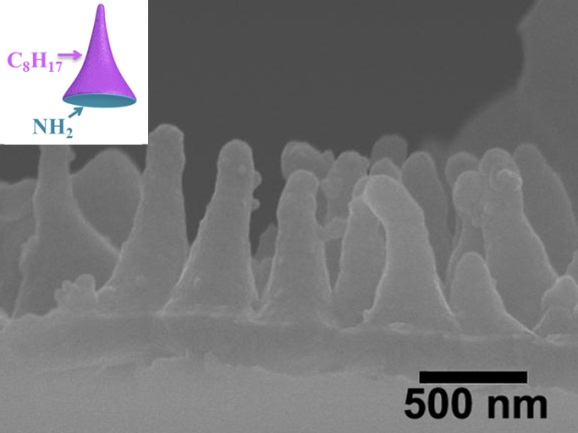
4. S. N. Yang, F. Y. Zhu, Q. Wang, F. X. Liang, X. Z. Qu,* Z. H. Gan*, Z. Z. Yang*, "Combinatorial targeting polymeric micelles for anti-tumor drug delivery", J. Mater. Chem. B, 2015, 3, 4043-4051.
Polymeric micelles of amphiphilic block copolymers have been studied for decades for their application as a targeting delivery agent of anti-tumor drugs. However, the targeting micelles may cause an immunological response because of the surface distributed ligands. In this work, mixed micelles were developed to improve the specificity of cancer cell uptake under tumor-acidic conditions. This was achieved by the co-assembly of an active targeting amphiphilic polymer, i.e. cyclic (Arg-Gly-Asp-D-Phe-Lys) c(RGDfK) functionalized poly(ethylene oxide)-b-poly(ε-caprolactone) (cRGD-PEO-b-PCL), and a pH sensitive drug conjugate, i.e.benzoic-imine linked PEGylated doxorubicin (PEG-DOX). Because the PEG-DOX is cleavable at the extracellular pH of a solid tumor, the characteristics of the mixed micelles turn from "stealthy" to cancer cell-affinitive due to the detachment of PEG from the micelle surface and hence allow the action of the c(RGDfK) in the cRGD-PEO-b-PCL with the cancer cell membrane. Besides, the mixed micelles exhibited the capacity for encapsulating hydrophobic drugs such as paclitaxel to form a combination formulation. Our results indicate that co-assembly is a facile but efficient strategy to coordinate the characteristics of each individual component and thus provide combinatorial functions to the delivery system.
5. Y. J. Liu, Q. Wang, X. Z. Qu, F. X. Liang*, Z. Z. Yang*, "Amide/acid composite Janus nanosheets", Sci. China Mater. 2015, 58, 126-131.
Janus materials have witnessed fast development due to their diversified promising performances and practical applications.Compared with their spherical counterparts, Janus nanosheets have gained more concerns for their highly anisotropic shape besides chemistry. Herein, 3.5 nm ultrathin and flexible Janus nanosheets with carboxyl group terminated onto one side are fabricated by surface sol-gel process of the self-assembled monolayer of an amphiphilic silane onto the template CaCO3 particle firstly. Amine/acid composite Janus nanosheets are further derived from these carboxyl group terminated silica Janus nanosheets by selective conjugation with amine groups onto the other side. The amine/acid composite Janus nanosheets are dually pH responsive, and well dispersible in aqueous solution at both low and high pH levels. The nanosheets are aggregated forming multi-layered face-to-back superstructures at intermediate pH levels. This is originated by the opposite electrostatic interaction between the carboxyl and the amine groups. This approach can be extended to other silanes, and a huge family of Janus nanosheets is expected with tunable composition and performance.
6. Q. G. Wang, F. X. Liang*, Q. Wang, X. Z. Qu, Z. Z. Yang*, "Responsive Composite Janus Cages", Chinese J. Polym. Sci. 2015, 33, 1462-1469.
Composite Janus cages of PS-silica-PEO are prepared using silica nanoparticles to sequentially crosslink di-block copolymers at an emulsion interface. Transverse channels are in situ created across the shell. The cages are capable to preferentially capture oil from aqueous surroundings. The saturation absorption capacity is determined by pH and oil property.
7. P. Zhou, Q. Wang*, C. L. Zhang, F. X. Liang, X. Z. Qu, J. L. Li and Z. Z. Yang*, "pH Responsive Janus Polymeric Nanosheets", Chin. Chem. Lett. 2015, 26, 657–661.
pH responsive polymeric Janus nanosheets with poly(maleic acid) moiety and crosslinked PS onto the corresponding sides have been synthesized by free radical polymerization. The Janus nanosheets can serve as solid emulsifier to stabilize an oil/water emulsion, whose stability is easily triggered by changing pH across pKa of the poly(maleic acid).
8. Z. G. Zhao, F. X. Liang*, G. L. Zhang, X. Y. Ji, Q. Wang, X. Z. Qu, X. M. Song, Z. Z. Yang*, "Dually Responsive Janus Composite Nanosheets", Macromolecules 2015, 48, 3598-3603.
Janus composite nanosheets of PNIPAM/silica/PDEAEMA are synthesized by sequential ATRP grafting two polymers from the corresponding sides of the Janus silica nanosheets. They are dually responsive to pH and temperature since wettability of the two sides is tunable accordingly. The nanosheets can serve as a responsive solid emulsifier. Type and stability of the emulsions are triggered by simple changing pH and temperature.
9. D. M. Lv, W. Ni, F. X. Liang*, Q. Wang, X. Z. Qu, Z. Z. Yang*, "One-Dimensional Janus Polymeric Vehicles", Chinese J. Polym. Sci. 2015, 33, 1344-1350.
The hydrophobic surface of poly(DVB-co-VBC) nanorod is modified with trimethylamine via quaternary ammoniation to hydrophilic. The Janus polymeric nanorods with hydrophilic external surface and hydrophobic interior core can be well dispersed in water can adsorb oil-soluble chemicals which are very similar to vehicles.
10. X. Y. Ji, Q. Zhang, X. Z. Qu, Q. Wang, X. M. Song*, F. X. Liang*, Z. Z. Yang, "Poly(ionic liquid) Janus Nanosheets towards Dye Degradation", RSC Adv. 2015, 5, 21877-21880.
Polymeric ionic liquid (PIL) functionalized Janus nanosheets are synthesized by polymerization of ionic liquid monomers onto the ATRP agent modified side of the silica Janus nanosheets. PW12O403− anion is introduced onto the PIL side through anion exchange. The PW12O403− based PIL Janus nanosheets at the emulsion interface exhibit excellent catalytic degradation of water soluble dyes for example methyl orange (MO).
11. Q. G. Wang, Y. J. Liu, X. Z. Qu, Q. Wang, F. X. Liang*, Z. Z. Yang*, "Janus Nanosheets by Emulsion Interfacial Crosslinking of Reactive Surfactants", Colloid Polym. Sci. 2015, 293, 2609-2615.
Polymeric Janus nanosheets are synthesized by crosslinking the self-assembled monolayer formed by a reactive polymer surfactant at an oil/water interface. The hydrophobic segments are frozen by the internal phase of solid paraffin, the reactive hydrophilic carboxylic acid groups exposed to the external aqueous phase can be selectively crosslinked to form an intact nanomembrane. The polymeric Janus nanosheets can be easily functionalized to derive a series of composite nanosheets. The composite Janus nanosheets can serve as new solid surfactants which are responsive to pH or magnetic field.
12. Y. J. Sun, F. X. Liang*, X. Z. Qu, Q. Wang, Z. Z. Yang*, "Robust reactive Janus composite particles of snowman shape", Macromolecules 2015, 48, 2715-2722.
We present a facile approach toward snowman-like silica@PDVB/PS Janus particles by seed emulsion polymerization using a gelable monomer MPS against a PDVB/PS hollow particle. Individual silica bulge is protruded from the seed particle surface, whose size is tunable. The silica@PDVB Janus particles are derived after dissolution of PS, which are robust to tolerate against organic solvents. Both sides are reactive for selective modifications to grow desired materials with tunable wettability and functionality. As solid emulsifiers, the Janus balance of the particles is tunable from more hydrophobic to more hydrophilic by changing either aspect size ratio or composition of the two sides.
13. H. L. Yang, F. X. Liang*, Y. Chen, Q. Wang, X. Z. Qu, Z. Z. Yang*, "Lotus Leaf Inspired Robust Superhydrophobic Coating from Strawberry-like Janus Particles", NPG Asia Mater. 2015, 7, e176.
We demonstrate a one-step approach toward the large-scale fabrication of robust superhydrophobic coatings using strawberry-like hemispherical Janus particles. Hemispherical Janus particles are capable of self-organizing into a layer on substrates. Nanoscale roughness on the hydrophobic hemispherical side determines the superhydrophobic performance. The imidazolin group on the hydrophilic flat side determines the coating strength by covalent binding onto substrates via cations initiating the crosslinking of the intermediate epoxy resins. The coating can tolerate organic solvents and high water flushing speeds. If the hydrophobic side is smooth, then the coating is highly adhesive to water. This procedure can fabricate unique coatings on a diverse range of substrates with varied compositions and shapes.
14. 周鹏,刘宝,梁福鑫,王倩,屈小中,杨振忠*, "Janus纳米材料微结构连续调控",高等学校化学学报,2015, 36, 1431-1436。
以聚苯乙烯中空微球为种子,以硅烷偶联剂3-(甲基丙烯酰氧)丙基三甲氧基硅烷(MPS)、氨丙基三乙氧硅烷(APTES)、无机物前驱体正硅酸乙酯(TEOS)溶胀其壳层。三种硅前驱体在种子球表面溶胶-凝胶,亲油和亲水基团在界面诱导下自组织分别朝向种子球和水相,在聚合物中空微球表面形成Janus结构。溶解除去聚苯乙烯,得到Janus纳米材料。通过调节pH值、硅前驱体用量,实现对Janus纳米材料微结构的连续调控,得到Janus中空球和纳米片。
15. S. Q. Cui, X. Y. Ji, F. X. Liang*, Z. Z. Yang*, "Ionic Liquid Functionalized Polymer Composite Nanotubes towards Dye Decomposition", Chin. Chem. Lett. 2015, 26, 942–945.
Poly(ionic liquid) functionalized composite nanotubes are achieved by ATRP grafting ionic liquidmonomers for example ViEtIm+Br- from the poly(DVB-co-VBC) nanotubes surface. PW12O403- anion is introduced through anion exchange. The PW12O403- based composite nanotubes can synchronously absorb and decompose water soluble dyes for example methyl orange (MO). The cooperative interplay is promising in highly efficient decomposition of dyes.
16. Z. Q. Cao, G. J. Wang*, Y. Chen, F. X. Liang, Z. Z. Yang*, “Light-Triggered Responsive Janus Composite Nanosheets”, Macromolecules 2015, 48, 7256-7261.
We report the synthesis of light-triggered Janus composite nanosheets and their Janus performance. Onto the amine-group terminated side of silica Janus nanosheets, a photo-responsive spiropyran-containing polymer (PSPMA) brush has been prepared by ATRP, while the other side terminated with hydrophobic octyl groups is preserved. Upon UV irradiation, the hydrophobic PSPMA side becomes hydrophilic since the hydrophobic spiropyran changes to the hydrophilic zwitterionic merocyanine form (or vice versa with visible light). Consequently, the PSPMA/silica composite nanosheets become Janus from hydrophobic or vice versa. The Janus composite nanosheets can serve as a responsive solid emulsifier, thus the stability of the emulsions can be remotely triggered with light. Unlike those pH- or temperature-responsive Janus materials, the light-triggering process requires no additional input of chemicals or thermal energy.
17. R. H. Deng, H. Li, F. X. Liang, J. T. Zhu*, B. H. Li*, X. L. Xie, Z. Z. Yang*, “Soft Colloidal Molecules with Tunable Geometry by 3D Confined Assembly of Block Copolymers”, Macromolecules 2015, 48, 5855-5860.
We present with experiments and computer simulations that colloidal molecules with tunable geometry can be generated through 3D confined assembly of diblock copolymers. This unique self-assembly can be attributed to the slight solvent selectivity, nearly neutral confined interface, deformable soft confinement space, and strong confinement degree. We show that the symmetric geometry of the colloidal molecules originates from the free energy minimization. Moreover, these colloidal molecules with soft nature and directional interaction can further self-assemble into hierarchical superstructures without any modification. We anticipate that these new findings are helpful to extend the scope of our knowledge for the diblock copolymer self-assembly, and the colloidal molecules with new composition and performance will bring new opportunities to this emerging field.
18. Y. Lv, A. L. Li, F. Zhou*, X. Y. Pan, F. X. Liang, X. Z. Qu, D. Qiu*, Z. Z. Yang*, “A Novel Composite PMMA-based Bone Cement with Reduced Potential for Thermal Necrosis”, ACS Appl. Mater. Interfaces 2015, 7, 11280-11285.
Percutaneous vertebroplasty (VP) and balloon kyphoplasty (BKP) are now widely used to treat patients who suffer painful vertebral compression fractures. In each of these treatments, a bone cement paste is injected into the fractured vertebral body/bodies, and the cement of choice is a poly(methyl methacrylate) (PMMA) bone cement. One drawback of this cement is the very high exothermic temperature, which, it has been suggested, causes thermal necrosis of surrounding tissue. In the present work, we prepared novel composite PMMA bone cement where microcapsules containing a phase change material (paraffin) (PCMc) were mixed with the powder of the cement. A PCM absorbs generated heat and, as such, its presence in the cement may lead to reduction in thermal necrosis. We determined a number of properties of the composite cement. Compared to the values for a control cement (a commercially available PMMA cement used in VP and BKP), each composite cement was found to have significantly lower maximum exothermic temperature, increased setting time, significantly lower compressive strength, significantly lower compressive modulus, comparable biocompatibility, and significantly smaller thermal necrosis zone. Composite cement containing 20% PCMc may be suitable for use in VP and BKP and thus deserves further evaluation.
19. P. Zhou, F. X. Liang, Y. J. Liu, R. H. Deng, H. L. Yang, Q. Wang, X. Z. Qu, Z. Z. Yang*, "Janus Colloidal Copolymers", Sci China Mater 2015, 58, 961–968.
We propose a new type of nanocomposite that we call Janus colloidal copolymers (JCCPs). JCCPs have two different polymers conjugated on opposite sides of a nanosized colloid. Janus clusters of copolymer PS-b-PAA (where PS is polystyrene and PAA is poly(acrylic acid)) are self-organized within confined mesoporous silica channels onto the surface of iron oxide (Fe 3 O 4 ) core particles by coordination-induced adsorption. PScPAA diblock JCCPs are fabricated by selective crosslinking of the nanosized PAA domains. In addition, the crosslinked PAA domains are terminated with amine-capped polyethylene glycol (PEG) to form PS-cPAA-PEG triblock JCCPs. The cPAA domain containing functional groups can serve as a nanoreactor to allow in situ preparation of functional materials. The composite JCCPs combine the functionality of nanosized colloids with the amphiphilic performance and self-organization capability of copolymers.
